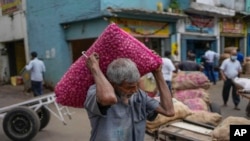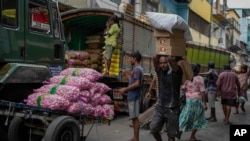There is always a long line waiting to enter at the dozens of community kitchens that have been set up in Sri Lanka by nonprofits and charities in recent months.
“Even today we had to turn back some people after serving over 300 meals,” Moses Akash, national director at the Voice for Voiceless Foundation in Colombo, which opened 12 community kitchens in June as runaway inflation made food unaffordable for millions, told VOA.
“People are desperate. For example, one family pushes their mother in a wheelchair for 5 kilometers to come. Some are surviving with only one meal,” he said.
These sorts of initiatives are lessening hardship for many as Sri Lanka grapples with a devastating economic meltdown. Akash said their kitchens feed about 1,800 people daily.
Those efforts, though, can barely meet a fraction of the massive needs in a country where over a quarter of its 22 million people do not have access to adequate food, according to the World Food Program.
“Around 6.3 million people in Sri Lanka are food insecure. That means they are not able to access nutritious diet on a regular basis, out of which around 5.3 million people are either reducing meals or skipping meals,” Abdur Rahim Siddiqui, WFP’s Sri Lanka country director, said in an interview with VOA.
Record low foreign exchange reserves have made it difficult to import food and fuel in a country that relied on shipping many essential commodities in from overseas. The problem was compounded after an abrupt switch to organic farming ordered by the government last year shrank local harvests – about half of last year’s rice crop was lost. The chemical fertilizer ban has since been lifted but the shortages have made food scarcer.
As a result, prices have skyrocketed, and food inflation hit 90% last month. The prices for staples such as rice and vegetables have doubled. Cooking gas cylinders are both expensive and in short supply, making it difficult for many to keep kitchen fires burning.
Preparing vast pots of rice and curry in community kitchens for hundreds is also a massive challenge. People have to cook with firewood, but getting adequate stocks is tough in Colombo.
“We began serving cooked meals when we realized that many people could not use the dry rations that we had been distributing,” Akash said.
There are other hurdles – the acute fuel shortage has severely restricted public transportation, making it hard for volunteers to come.
The urban poor and rural families, who already had long faced malnutrition, are the hardest hit.
Siddiqui said 70% of Sri Lankan children were stunted even before the COVID-19 pandemic and the economic crisis erupted.
“That means their height was lower than their age and around 15% were wasted, that means they were too thin for their height. With this crisis, my understanding is that the nutritional situation will further worsen in the coming days,” he said.
The hunger crisis has been worsened by income losses in the hard-hit transportation and tourism sectors, that are the mainstays of the country’s economy and huge income generators.
“For instance, there were lots of three-wheelers in Colombo in the past but now there are fewer in number because they are unable to get the fuel or are given very restricted supplies,” Jehan Perera, executive director at the National Peace Council in Colombo, told VOA.
“Now those people can’t earn an income and then they are faced with these high prices,” he said.
Government funding for programs, such as one providing school children a free meal, have been cut.
The WFP has launched an emergency program aiming to reach over 3 million of the most vulnerable segments of the population, such as pregnant and breastfeeding women and school children.
Coming months could see a further spike in food prices.
Farmers are again facing fertilizer and fuel shortages as the cash-strapped government is unable to fund their purchase. That has raised fears that agricultural production could plummet for a second year.
“If all those items are not readily available, I am quite worried that the upcoming season which will be coming in October-November, that might be impacted,” Siddiqui said.
“So, it is imperative that we have all the inputs available,” he said.
However, it is unlikely that shortages of fertilizers or fuel will ease anytime soon.
The country is negotiating with the International Monetary Fund for a bailout, and discussions for a four-year program that could provide up to $3 billion would resume this month, President Ranil Wickremesinghe told parliament this week.
It could still take months to put a final agreement in place, though. Wickremesinghe warned last month that the country will have to face difficulties in 2023 as well.
Observers call the situation “catastrophic” for the poor.
“We cannot import food because we don’t have the dollars and internally there is a short supply,” Perera said.
“Crops in one part of the country cannot be sent to another due to diesel and petrol shortages. Things will only get worse for a while,” he said.










